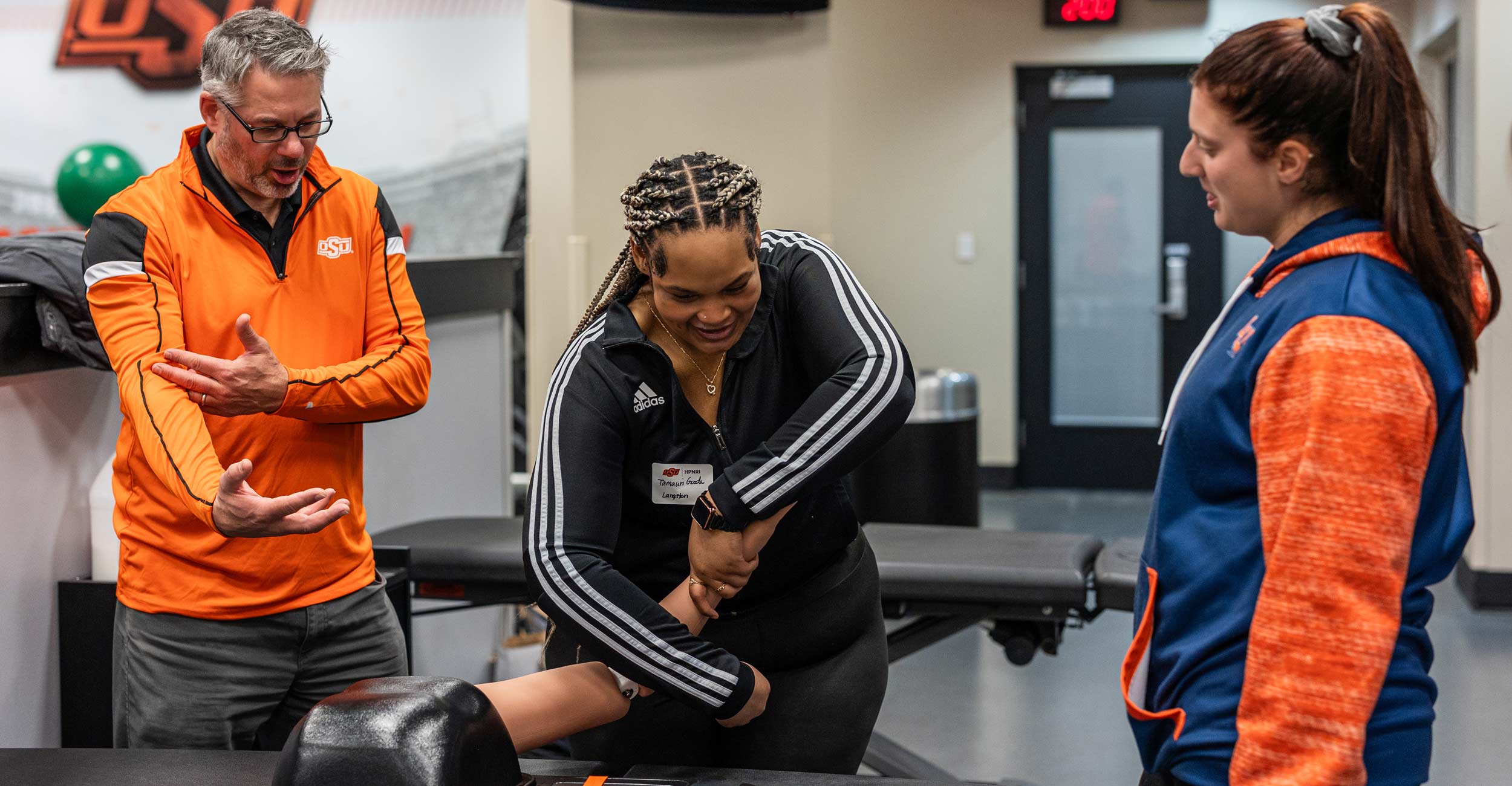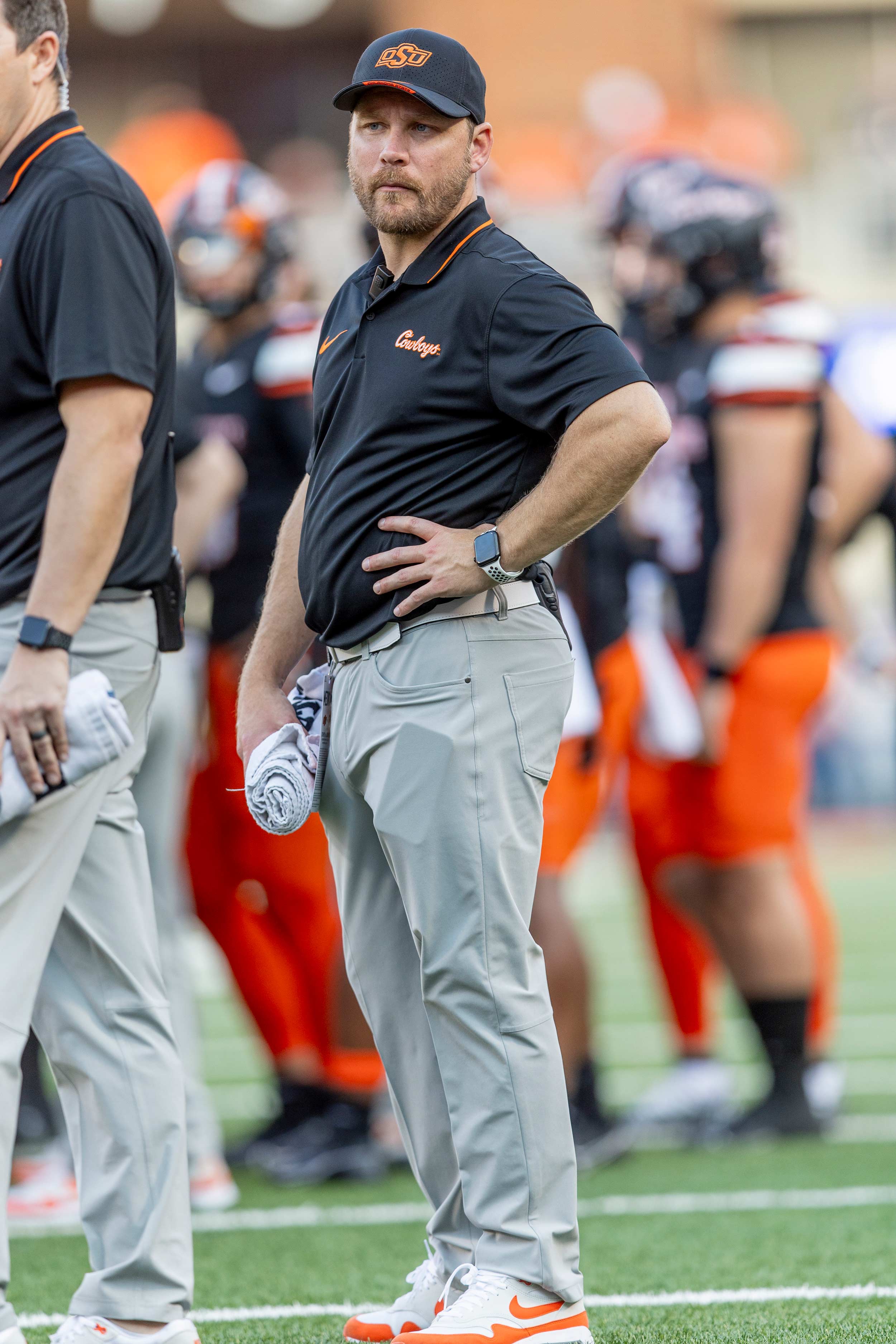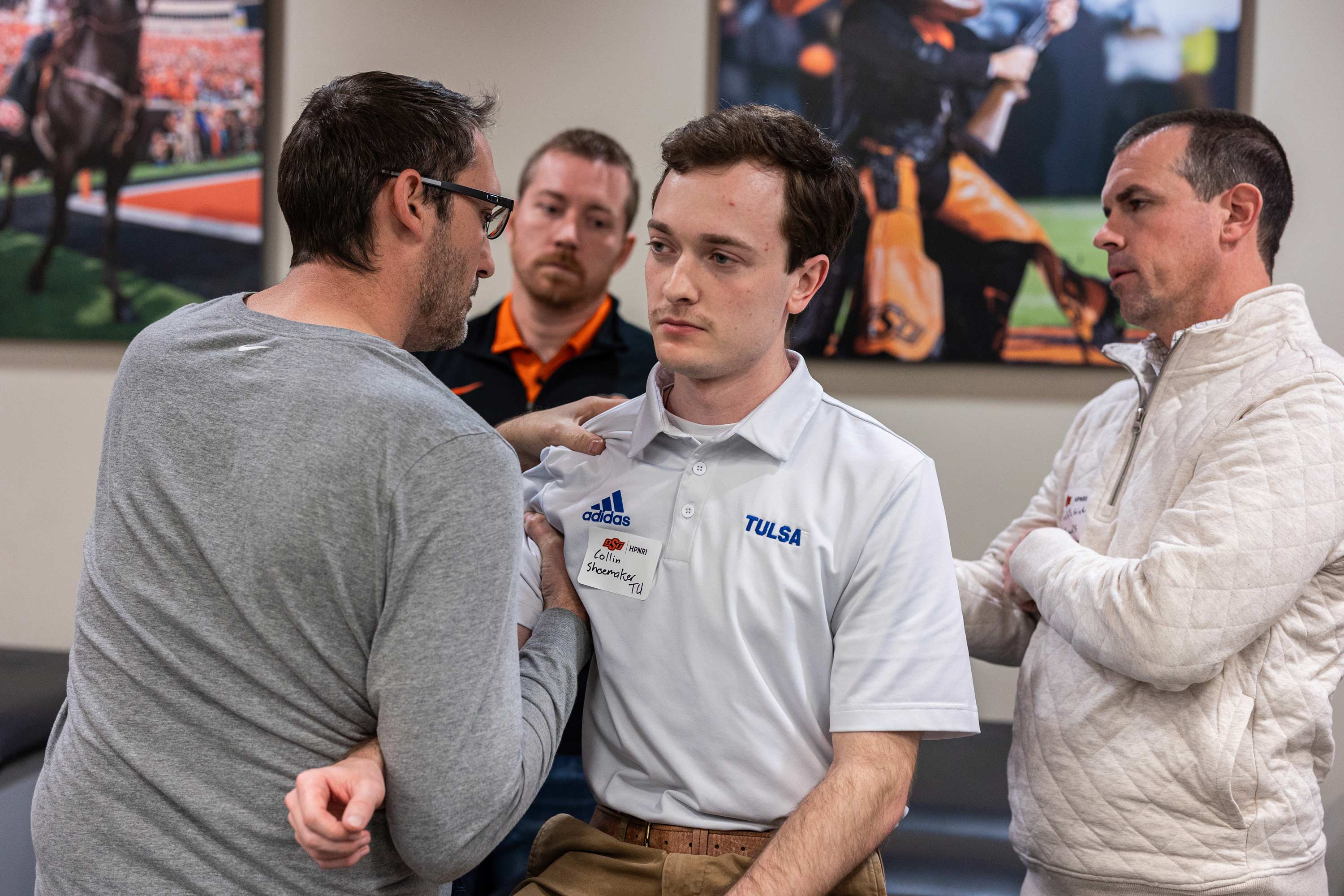
National athletic training month highlights crucial role in student athlete safety and health
Wednesday, March 13, 2024
Media Contact: Sydney Trainor | Communications and Media Relations Specialist | 405-744-9782 | sydney.trainor@okstate.edu
Whether it's a professional athlete like Damar Hamlin or a 14-year-old Tuttle, Oklahoma, wrestler, the presence of an athletic trainer can be lifesaving.
March is National Athletic Training month. The Oklahoma State University Human Performance and Nutrition Research Institute under the umbrella of The Innovation Foundation is spreading awareness about the importance of athletic training roles on performance.
The OSU Center for Health Sciences, in collaboration with OSU Athletic Training and HPNRI, launched the Athletic Training – Sports Medicine ECHO program in May 2023. It provides expert knowledge of best practices in the identification, reduction and treatment of sports-related injuries to keep student-athletes active, healthy and expedite return to play.
Participants learn about policy implementation and management strategies to improve health outcomes, sustainability and the quality of life across Oklahoma.
“Athletic Trainers save lives,” said Lance Walker, Rick and Gail Muncrief executive director of HPNRI. “They are essential frontline healthcare professionals and unsung heroes who play a pivotal role in safeguarding the health and well-being of our student athletes, often saving lives through their expertise and dedication."
Dr. Aric Warren, OSU-CHS athletic training professor, serves as the hub team lead where he facilitates each session and helps develop the curriculum. The program brings elite professionals across different disciplines from physical therapy and strength conditioning to high school athletic trainers and collegiate team physicians. The team also includes dieticians and mental health professionals.
“Statistically, in Oklahoma roughly 70% of schools do not have access to an athletic trainer,” Warren said.
The goal of the interactive telementoring space is to foster interaction and mutual learning among clinicians, emphasizing best practices across diverse clinical settings. The sessions are also modeled with an approach, known as “All teach, all learn,” which encourages participants to share insights and knowledge.
A lot of things have changed over the years in sports medicine, but one constant remains
– the important role and impact of the athletic trainers. Our training staff works
seven days a week while in season. The sacrifices they make for their athletes and
teams often go unnoticed. Any coach that has had lasting success recognizes the vital
role their athletic trainers plays within the team.
The goal of these sessions is for entities to recognize the importance of athletic trainers. They not only support student-athletes in achieving their goals but ensure their safety and potentially save lives.
"Sometimes there's a bit of a misconception that the only way we're going to get an athletic trainer is if we're a large 6A school, and those are the only kinds of athletes that need our care and services. That's simply not the fact at all,” Warren said. “Many of the topics we discuss deal with conditions that could be fatal if not handled appropriately. We talk about being prepared and having emergency action plans in place so if we recognize one of these conditions, it's handled appropriately to save lives.”
As a parent, Warren regularly attended his children's athletic events, ranging from dance competitions to soccer or gymnastics tournaments. Every time he arrived at an event, he couldn't help but wonder: Where was the medical tent? Was there adequate medical care available? What if his child got hurt?
Those big questions are in the back of parents' minds who are uncertain on how to find answers. Some parents even attend ECHO sessions to access resources and to recognize and manage injuries or conditions effectively.
With this information, they can educate their own children or enhance the awareness of individuals at their school to handle such conditions.
Taking the First Step
Anyone interested in becoming an athletic trainer can get their start at OSU. There are several undergraduate degrees that segue well into the OSU-CHS's athletic training master's program like an applied exercise science, nutrition or physiology.
The OSU College of Education and Human Sciences offers a program known as the three plus two degree accelerated pathway. Students initially spend three years in Stillwater, pursuing degrees in health promotion, nutrition or exercise science. Then, during their fourth and fifth years, they transition to the OSU-CHS campus in Tulsa to complete their master’s program. This structured approach allows students to obtain both their bachelor's and master's degrees within five years.
Once certified, the opportunities are endless for athletic trainers.

Daniel Lynch grew up playing football in Fort Myers, Florida, where he experienced small injuries in high school that left him occasionally on the sideline during games. Those injuries introduced him to a physical therapist who was also a certified athletic trainer with a high-level sports organization, sparking Lynch’s interest in a similar career path.
He learned that athletic training was a great way to get started in the medical field. Then, he could specialize through higher education degrees and become certified in other specialties and eventually work for a college or professional sports organization.
Lynch received offers to play college football but faced a decision: attend a larger school and work to possibly earn playing time or choose a smaller school to play football and pursue a degree in athletic training. Opting for the latter, Lynch moved from Florida to Columbus, Ohio, to attend Otterbein University.
“It was a little bit of a culture shock, weather shock, but I graduated from athletic training school in 2010. And I've been an athletic trainer since 2011,” Lynch said.
During his last semester at Otterbein, Lynch interned with the Tampa Bay Buccaneers where he was introduced to their director of rehab who was an athletic trainer but also a physical therapist — a role that interested Lynch.
Lynch began talking with him mentioning that he started with an internship as an athletic trainer, then pursued physical therapy school while continuing to work as an athletic trainer. Lynch found the rehab director’s path intriguing and decided to emulate that path for himself by enrolling in PT school at University of St. Augustine for Health Sciences.
“I obviously enjoyed injury management, on-field evaluation, emergency action planning and some of the management of student-athletes, I thought that was interesting, but really where I found my passion was in the rehabilitation side of things,” Lynch said.
Passionate about getting more immersed in collegiate and professional athletics, Lynch applied for a residency at Duke University. Despite not securing the residency, he remained optimistic, and considered gaining experience with a professional or collegiate organization before pursuing a fellowship.
Eventually, Duke's rehabilitation director offered Lynch a job in the sports medicine outpatient services, allowing him to work as both an athletic trainer and physical therapist straight out of school.
Lynch worked as an outreach athletic trainer to various high schools in the area, while also providing physical therapy services at a clinic. This position provided invaluable experience for two years, allowing him to serve as a liaison for orthopedic surgeons and deliver post-operative care onsite at high schools.
Searching for the next step in life, Lynch took a position working for an orthopedic surgeon who was the team doctor Florida Gulf Coast University. Lynch then began volunteering in collegiate athletics, but after a year, he realized wanted to be immersed in a more full-time role as an athletic trainer.
Eventually, Lynch applied to fellowships and landed back in Durham, North Carolina, in one of the most coveted Division 1 sports physical therapy fellowships at Duke.
“At the summation of my fellowship, which was a great opportunity, I took a lot of the skills and practices learned during the four or five years leading up to that fellowship, and really solidified my passion for collegiate athletics, but then also football, specifically, so I was really looking for a job to open up for football in either collegiate or professionally,” Lynch said.
A position opened prompting Lynch and his family to move to Stillwater, Oklahoma to work as an athletic trainer and physical therapist for Cowboy football.
“A large part of my jobs leading up to this point were associated with orthopedic surgeons,” Lynch said. “So, I saw a lot of different surgeries, a lot of different surgical approaches and how to rehabilitate them. I had quite an extensive background on post-operative care so that's my focus when it comes to rehab but day-to-day I’m also involved in athletic training skills like taping and emergency action planning.”
Game Day Preparation
During the football season, the OSU athletic trainers have an intense schedule, running from 6 a.m. to 6 p.m., seven days a week, focusing on practice and preparation for upcoming games.
The athletic training clinic typically opens at 6 or 7:30 a.m., with players engaging in lifting sessions and rehab exercises to recover from injuries and enhance performance. This routine continues until around noon, encompassing various recovery strategies and treatments to keep the players in top shape.
"There's always eyes on the drills and there's always eyes on the sidelines, there's
always eyes on the game. We're watching the action but with a different intention
and different purpose. A lot of people say ‘Oh, wow, look at that play or the running
back at work.’ I usually look at the alignment of knees as players are rolling on
top of each other and things like that. So, my eyes are usually not where the ball
is.”
Taping sessions typically start in the mid-afternoon before player meetings. After meetings, players head to practice, where Lynch is part of a team that oversees modified drills and periodically checks on post-operative players as they progress. During more intense practices involving live drills or hitting, Lynch remains nearby to monitor for potential injuries, ensuring prompt attention and communication with coaches. He coordinates with other athletic trainers to maintain awareness over the players and gather crucial information in case of injury occurrences.
"There's always eyes on the drills and there's always eyes on the sidelines, there's always eyes on the game,” Lynch said. “We're watching the action but with a different intention and different purpose. A lot of people say ‘Oh, wow, look at that play or the running back at work.’ I usually look at the alignment of knees as players are rolling on top of each other and things like that. So, my eyes are usually not where the ball is.”
Just like many fans, Lynch and the rest of his team are at football games four hours before kickoff. With help from their student employees, they set up the sidelines and prepare mentally for the game.
Two hours before game time, players make their walk down Hester Street to Boone Pickens Stadium where they go to the athletic training clinic for taping and preparation. Not only do the athletic trainers get the players ready for the game, they are also preparing themselves to act quickly, making sure automated external defibrillators and other emergency equipment are in place and communicating with EMS.
“I personally like to review our action plans before the games, especially early on the season, just to refresh because I've been off season for a while,” Lynch said.
The OSU athletic trainers usually communicate with the visiting team before the season, before they arrive and then before the game starts. They go over the emergency action plan, codes and hand signals.
“Even though we're on opposing teams, we're all part of the same team, we take care of the athletes,” Lynch said.
In traditional settings, athletic trainers are commonly associated with athletics, spanning from high school sports to professional athletics.
"Athletic training is a great career,” Lynch said. For me being a previous athlete, there's such a connection to the athletes and the coaches. There's a team approach and being a part of a team and being part of a collective is always, always nice, in my opinion. It makes you feel like you belong to something, makes you feel like you're a part of something that's bigger than you and that your day-to-day hard work is paying off for the good of others.”
Branching Out
For many, athletic training ends at sports or athletic events when in reality the profession is seen across the medical field and in industrial settings.
In other cases, they are increasingly utilized in emerging practice settings, where their involvement intersects both sports and industrial settings.
“Those athletic training roles might be with NASCAR or the racing industry,” Warren said. “Military settings are also growing because there are a lot of military bases and they're doing a lot of different new programs and new funding in the military sector to hire athletic trainers to be there with their soldiers and with their trainees to get them prepared for missions.”
The industrial sector is also another rapidly emerging setting involving a wide variety of industries from energy to aerospace and manufacturing, even companies like Amazon, Warren said. These companies employ thousands who could possibly get injured on the job, so they are hiring athletic trainers to work as injury prevention specialists and injury care specialists.
In university settings, another emerging role for athletic trainers involves collaborating with the departments of wellness or recreation. They provide care for the general student body, faculty and staff, including those participating in recreational activities, intramural sports, clubs and sports. They also assist individuals who sustain injuries on campus, offering evaluations, treatments and exercises. These positions are primarily focused on collegiate populations, but they also involve working with faculty and staff of varying ages and activity levels within a campus environment.

The third setting common for an athletic trainer would be in a physician practice setting.
Whether it be orthopedic practice, primary care, sports medicine practice or even in emergency medicine, athletic trainers are hired to work as mid-level providers to help facilitate patient flow, and manage patient volume, Warren said.
"Sometimes the first person you see within an examination room is a nurse, PA, or medical assistant,” Warren said. “Many times, now, that person is an athletic trainer. They can do the initial injury screen and evaluation and start different imaging studies to facilitate better patient flow in the whole practice setting. That allows for physicians to see more patients within a day, but also to help them prioritize where their attention is going to be best spent with different patients and different cases.”
It’s not uncommon for athletic trainers to assist in the operating room during surgery and prepare tissue grafts or patient positioning and instrumentation during surgery.
Being an athletic trainer is more than just caring for the physical well-being of athletes.
It’s a selfless role that demands sacrifice and constant encouragement for athletes, Lynch said. While Cowboy football athletes have access to mental health professionals, dietitians and other specialists, athletic trainers serve as the immediate support system for athletes, fostering rewarding relationships and guiding them through challenging times such as injuries.
A Worthy Cause
Despite the emotional toll, witnessing the progress and victories of athletes makes the job incredibly fulfilling and worthwhile. It's a demanding yet gratifying profession that requires dedication and focus, he added.
In some areas where access to athletic trainers may be limited, Warren has seen school administrators and nurses attend the sessions to help the students in their community. He hopes to even see parents and concerned individuals start to attend the sessions to learn more about why athletic training is important but to also learn ways they can educate themselves for the safety of student athletes no matter the size of the school.
“Our goal with the ECHO sessions is to help individuals that are in remote areas of the state, in underserved areas, or are clinicians that want to learn more and enhance their skill set, improve their patient outcomes.”
Each session focuses on discussing key topics and extracting three or four actionable insights from the latest research and best evidence, empowering participants to implement these practices in their patient care.
A major goal of these sessions is to advocate for the profession of athletic training in rural communities and in schools that don't have access to an athletic trainer.
“Here at Oklahoma State, we have a great reputation for believing and supporting our athletic trainers,” Lynch said "That's something we do well here from our administration and above. We take care of our athletic trainers, and we support them.”
